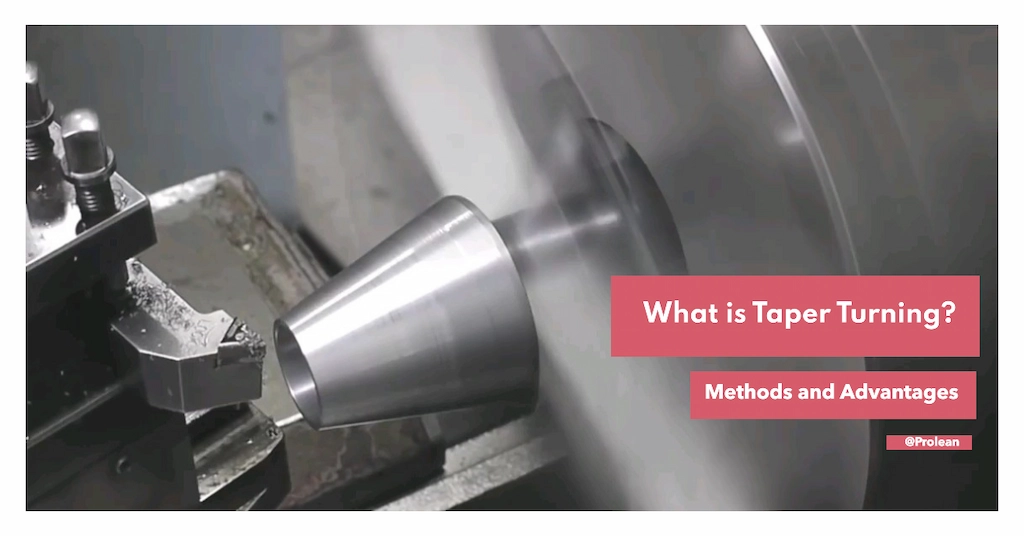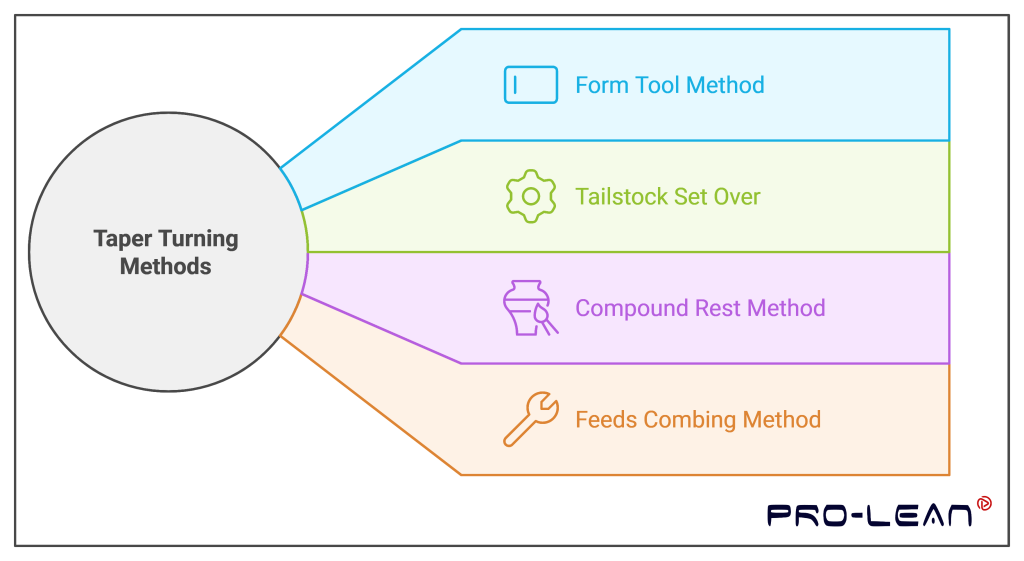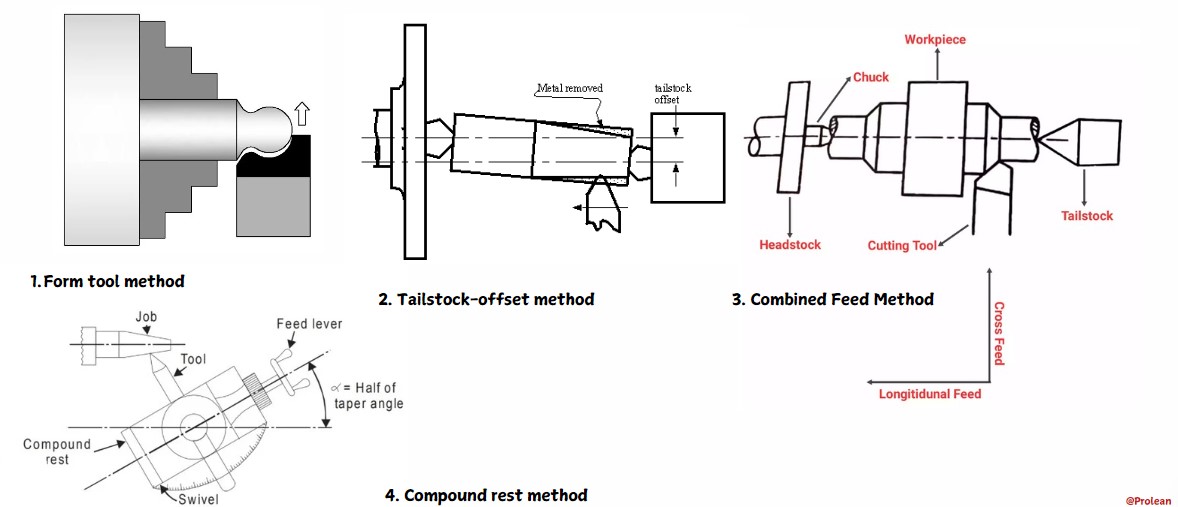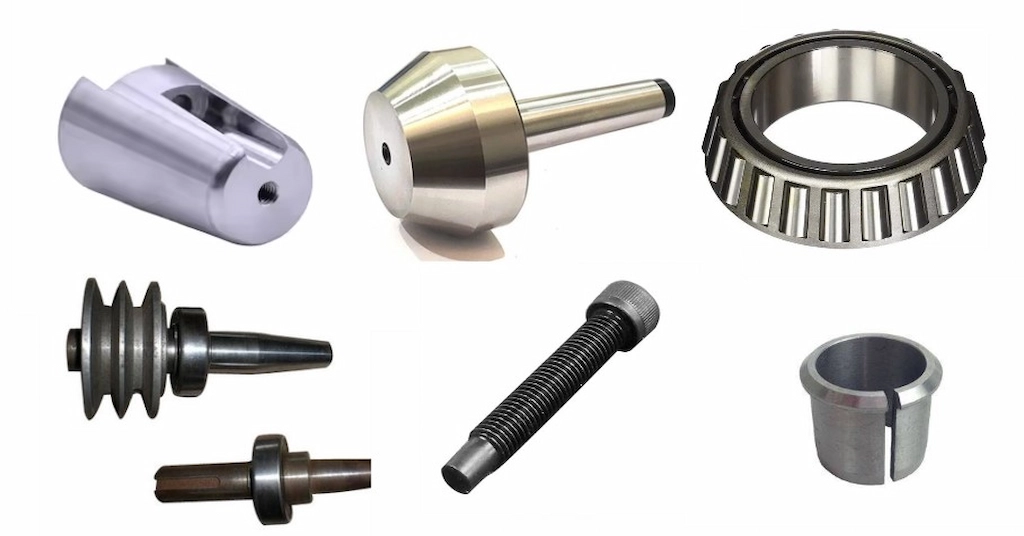“Taper turning produces a smooth conical surface that allows tight and reliable connections, from machine spindles and tool holders to drive shafts.”

A taper shape refers to a gradual and consistent increment or decrease of diameter along the length. It is an axially symmetrical geometry, that is mainly created using the CNC turning process, specifically, the taper turning operation. This operation involves consistently changing the cutting depth on the cylindrical workpiece.
The taper-turned parts are used in automotive, construction, tooling, industrial plants, and many other sectors. Consequently, custom parts for assembly and alignments also require taper turn machining. This article will go through the process of cutting a taper, its methods or types, its importance, applications, and tooling.
What is Taper Turning?
Taper turning is a lathe process where the material removal process is carried out to consistently decrease or increase (alter) the diameter of cylindrical work along its length. As a result, it produces symmetric conical or taper geometry, such as drill bits, spindles, valve seats, and shafts. Besides these, this operation is also prevalent for clearance, appearance, and weight reduction purposes.
Another thing that needs to be clarified is that the diameter change is not sudden or step-wise. Instead, it changes at a steady rate. The standard unit of taper turning is change diameter per unit length. For example, taper turning of 1: 10 means a total 1 mm gradual diameter change in the 10 mm length of the workpiece(Ø 1/ 10 mm length). However, it is also measured in taper/inches or taper/degree.
The formula for taper calculation;
Taper per unit length (t)= Large diameter end (D)-Small Diameter End (d) / Length
Tailstock setoff, compound rest, taper turning attachment, form tool, and other methods are used to cut the tapered items.
Try Prolean Now!
What are the Two Types of Taper?
After what is taper turning, let’s go to the taper types. There are two main types of tapers; self-holding and self-releasing taper.
1. Self-Holding Taper
This type of taper(such as the Morse taper) grips tightly and resists separation without the need for additional fasteners. It’s used in situations where the tool or component should remain firmly in place during use.
2. Self-Releasing Taper
This type of taper( such as the Jacobs taper) does not hold as tightly under load and is easier to separate. It’s used where frequent removal and replacement of tools are needed.
Taper Turning Methods

Like all other turning operations, there are various methods to machine the tapered shape in a CNC lathe or machining center. Each of these taper turning methods executes the design with different tooling approaches. So, based on the specification of the tapered shape, you can use the best-fit methods.

Taper turning methods
The following are the common taper turning methods used in CNC manufacturing;
- Form Tool Method
It simple and precise method for cutting a taper, a formed tool with a specific tapered angle that direly removes the material by feeding the rotating workpiece at half taper angle. The process generates considerable vibration at the start of machining and the tool’s straight length is higher than the required taper length. The form tool taper turning method is useful for short-length tapers with tight tolerances.
- Tailstock Set Over Method
Tailstock set over method achievers the tapered shoes by adjusting the rotation axis of the workpiece. It achieves this small shift of axis by altering the original tailstock position.
First, the workpiece is set on the straight alignment position of the head and tailstock with respect to the axis of rotation. Meanwhile, work involves relatively loose claiming to allow the offset of tailstock alignment. Here, is how you can find the required offset;
Offset (mm) = Required taper size X length / 2000
Next, set the cutting tool in the center of the workpiece and start the machining. This taper turning method is suitable for external tapering with small top angles.
- Compound Rest Method
Compound rest feeds the workpiece using a cutting tool directed at a certain angle. It is a versatile method that can taper small to large angles. The compound rest is installed on top of the cross slide, which itself is mounted on the carriage of the lathe. Consequently, compound rest tapering is suitable for the steep turning of cylindrical workpieces.
After setting the right rest angle compound rest, it locks the direction of the cutting tool. The formula to calculate the rest angles is;
Tan θ=(D−d/2L)
- Feeds Combing Method
The feed combining means diagonal movement of the tool by combining the linear and cross-feeding. So, it is one of the skilled-based techniques compared to other taper turning methods.
The continuous cross-feed makes the tool move in a diagonal direction and other variables like speed, and depth, can be adjusted based on the required characteristics of the taper. Although the operator needs to be highly experienced, it offers significant customization advantages.
What are the Examples of Taper Turning Parts?

Examples of tapered items
The taper-turning process is essential in producing tapered or conical components across all sectors. From industrial components to assembly items and aesthetic parts, this method serves diverse manufacturing needs.
Here is the list of taper turning application examples;
- Spindles
- Lathe centers
- Drill bits
- Gears
- Machine tools
- Wedges
- Mandrels
- Shafts and Bushings
- Bushings
- valve stems
- Aerospace landing gear and engine components
- Automotive parts, etc.
What Are the Advantages of Taper Turning?
The precision, complex features, material options, and other various characteristics of taper turning are beneficial in the production of tapered shapes.
The list below illustrates some key benefits;
- Complexity: This process can accommodate geometrical features like threads, intricate contours, internal conical shapes, etc.
- High Precision: The taper-turned parts can achieve a tolerance of ± .0002 over total diameter variation over length.
- Material Versatility: Taper turning is compatible with metal, alloys, plastics, composites, etc. It can even process hard-to-machine metals like titanium, tool steel, and nickel alloys.
- Customization: For assembly purposes, it can make custom clearance, fits, and other assembly items.
- Workpiece Length: A similar length of workpiece can be taper turned as A CNC lathe can do for other turning operations.
What Are the Disadvantages of Taper Turning?
- High upfront cost due to requirements of advanced equipment and tooling.
- Compared to other turning operations, tapering wastes more materials, i.e. high amount of material removal.
- There is a risk of excessive vibration during the turning and might require some additional setups to mitigate this.
- The machining speed is relatively lower than other lathe machining processes.
Can I Taper Turn on Swiss Turning Machines?
Swiss turn machine involves one precision feature additional to conventional CNC lathes. It uses a guide bushing to support and guide the workpiece while the tool removes the material from its surface. This support in Swiss turning eliminates the vibrations and allows for the machining of small and precise parts.
Yes, you can taper turn on Swiss turning machines. These machines are well-suited for tapering the small and intricate parts. The sliding headstock mechanisms can achieve tapers either through the use of a guide bushing or by programming the tool paths to create the desired taper. Examples are dental screws, aircraft fasteners, probes, watchmaking, etc.
Read More: Milling vs Turning
Try Prolean Now!
Summing Up
Overall, the taper turning process makes a conical and steeped tapered shape. It is suitable for precise and low-cost production of assembly items, industrial components, and custom products. Eg, shaft, bushings, tool handles, automotive and aerospace parts, drill bits, etc. Additionally, choosing the right method is equally critical for desired results.
At ProleanTech, we execute several tape turning methods with our multi-axis CNC lathes and machining centers. Our expert engineers and operators with a decade-long experience in CNC machining can deliver quality turning services for your conical and tapered-shaped items. Additionally, our custom tooling strategies can help you convert your designs with complex tapered features into life.
FAQs
What is meant by taper turning?
Taper turning is a turning machining process that creates a conical shape by gradually changing the diameter of a cylindrical workpiece along its length.
What are the different methods of taper turning?
Taper turning has different methods with unique tool setups and capabilities. Four of them are;
- Compound Rest Method
- Tailstock Set-over Method
- Taper Attachment Method
- Combined Feed Methods
Which method is ideal for steep tapers?
The Compound Rest Method is ideal for producing steep tapers due to its precise angular adjustments.
Can I taper-turn hard materials?
Yes, taper turning can be performed on hard materials. However, you might require specialized cutting tools material, hard coating, and slower cutting speeds.
Which is best for taper turning: the CNC lathe or the machining center?
A CNC lathe is generally preferred for taper turning due to its ability to accurately control taper angles and repeatability.




0 Comments